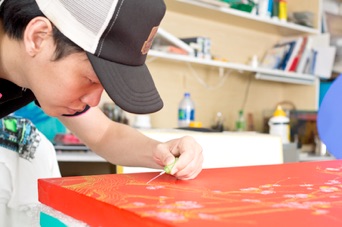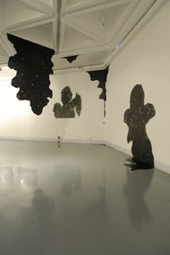Arthongkong.net meets with Lam Yau-Sum
- MYJade
- 2013年4月25日
- 讀畢需時 8 分鐘
"...I let the overall landscape of the circuit board “show” me what the final image is ~ I have a dialogue with the circuit board that is concurrently the canvas as well as the subject.""...
透過電子板上的線路和自己的想像力,順著不同的線路用筆推動,從而透過推動畫出不同的圖形,就好像和電子板 “溝通”,而電子板同時是畫布和主題。..."
Lam is a young man whose childhood interest led to a discovery. He is soft-spoken, a little shy, very understated. But once he gets into talking about art and his work, he lights up and gets very animated. It’s clear he loves his work, and he is focused and driven ~ the desire to push current boundaries and try new directions (e.g. sculpture) is apparent. Yet, although I can see there is a drive from within, his artwork is really more influenced by external factors. Such as the process of turning recycled
circuit-boards into works of art: it is really all about observing the “canvas” (in its raw state) laid out in front of him, observing the form, patterns, properties, from different angles and perspectives; and then letting those take him in the direction of the final artwork. His work is extremely detailed, and requires a substantial amount of control.
All in all, Lam is an interesting mix of internal and external
factors!
林佑森是一位年輕有為的藝術家,他的創作靈感源於童年時的興趣。他給我的第一印象是個談吐溫文,內斂而遜順的人。但當他一談到藝術創作和他的作品時,他便雀躍起來,說話也滔滔不絕,由此可見他對藝術創作的喜愛。此外,他對藝術創作也持有恆心,時刻希望在創作道路上尋求突破。除了持之而恆的決心外,他的藝術作品亦有溶入現實生活的元素。比方說,把被視為電子廢料的電子板改造成藝術作品,透過不同觀點與角度去細緻觀察電子板,就每塊電子板的原有構造,紋理和特性,以心領會,從而找到創作方向,把作品一氣呵成。他的作品精工細琢,對心神及雙手的同步運用極為講究。簡單來說,林佑森喜歡將內心世界和現實狀況混合在其作品中,使作品更細膩有趣。
Could you please share your background, and how did you end up in art?
My uncle was a big influence. I moved to Hong Kong from Guangdong from primary school onwards. Before moving, I had spent a lot of time with my grandparents and uncles. One of my uncles was an electrician – he was constantly fixing electronic items including computers. I followed him around, and picked up knowledge around electrical equipment, machines and also computers. In secondary school, a teacher stoked my interest in computers – and I even assembled my own computer.
But instead of studying electrical engineering in university, I elected to study Art (Lam has a Bachelor of Fine Arts degree from RMIT University). I felt that there was an element of creativity in working with electronics, but to fulfill my intellectual needs I didn’t need to learn the technicalities of electronics rather it was Fine Art training that I wanted.
你可以跟我們分享你的背景,為什麼會選擇藝術?
舅父對我的影響很大。小學時期由廣東移民來香港,我經常和婆婆,舅父們住在一起。二舅父是一名電器維修員,主要維修電視等電子產品。從他身上,我學會了很多有關電子,機器和電視的知識。中學期間,在老師的引導下,我開始接觸電腦,並嘗試自己購買零件組合電腦。
我決定在大學選修藝術,而不是電子工程,這是因為熱愛藝術創作,多於學習操控電子零件的技術。透過修讀藝術,獲取知識,這正是我對藝術創作的熱切追求。
Your artwork has an interesting feature – instead of canvas you use circuit boards! How did that come about?
I was around electronics and circuit boards a lot of the time… and that background filtered into my artwork. I started painting acrylic on canvas, with heavy emphasis on lines, dots, just like to circuit connectors you see on the circuit boards. This style even filtered into my paintings of human subjects. Although I like solid vibrant colours, back in those days I tended to mix them more. Then one day I hit upon the idea of doing away with the canvas and using the circuit boards instead. I let the overall landscape of the circuit board “show” me what the final image is ~ I have a dialogue with the circuit board that is concurrently the canvas as well as the subject. Although the work is still two dimensional, it is not flat as the boards have ridges, lines, dots which also have an integral part in the final outcome of the image.
運用電子板創作是你作品的一大特點!你怎麼想出來的呢?
時常接觸各種各樣的電器和電子板,那些經驗啟發了我的創作⋯運用帆布,注重線條,圓點 ─ 就好像電子板上的線路。我也用這風格畫人像。當時我把不同顏色混合才繪畫,雖然我本身比較欣賞燦爛的顏色。直到一天,我想到用電子板取代畫布,透過電子板上的線路和自己的想像力,順著不同的線路用筆推動,從而透過推動畫出不同的圖形,就好像和電子板 “溝通”,而電子板同時是畫布和主題。雖然畫面還是平面的,但並不平整,因為板上有線路和凹凸的粒子,這些都構成我的作品。
I also note you have canvas art, which draws from the circuit boards… particularly the lines and dots. When did you develop this?
I suppose you can call it my evolution. Circuit boards have their limitations, particularly in terms of size. I was getting to a stage where I felt limited in terms of what I could produce, but I really wanted to continue with the focus on lines (but using gongbi technique), and to see where I could go with Chinese landscapes that seemed to emerge from some of the circuit board artwork. I started a sketchbook just to develop this concept and later on moved on to actually working on canvas.
It’s not so much “painting” as using a piping mechanism to produce the images. The background is prepped and then the painstaking work on the images begins. The colours are bright, and each artwork is generally monochromatic as I want the attention focused on the landscape that is portrayed.
我發現你的帆布畫作品上亦會呈現出電子板面的線條和形狀。你甚麼時候發展出這種繪畫風格?
我想這可算是我創作上的一大突破。因為採用電子板取代畫布是有一定的限制, 尤其是作品的大小方面。同時,我明白我的作品種類亦會很有限,但是我仍想繼續專注於線條及將中國山水畫的元素結合到我的電子板作品上。所以我開始將這個概念畫在素描簿上,進而再引申到帆布畫的作品上。
這系列的作品與一般的繪畫稍有不同,我是使用針筒把顏料擠出來去描繪。首先我會把畫布面塗上單色,然後小心翼翼地把擠出顏料成每一線條和圓點。每件作品雖然是單色,但是顏色鮮艷,而作品上的山水面貌則成為了矚目的焦點。
What do you use to paint?
For my canvas works, I use oil with slower drying time and that produces a smoother, more even result. And I really enjoy the outcome, where the texture of raised lines adds an extra dimension to the landscape evoked by the painting. For the circuit board works, I use enamel paint, but the boards are first prepped to remove the soldered metal so that only the texture of the board itself is left, and then painted with a base layer of enamel.
你用哪種原料創作?
畫布作品用油畫顏料,因為比較耐乾,潤滑,效果均勻。我很喜歡這種效果,擠出來的線條增加了山水畫的真實感。我用磁漆,畫於電子板面,事前必須處理電子板,除掉所有金屬線等等,只是留下板,然後塗上底層磁漆。
Do you work, or do you paint full-time? What’s your schedule like to produce art?
Oh I’m like a lot of Hong Kong artists; when I first graduated I worked full-time. When I saved enough I cut my hours down to part-time work so that I have more time for my art. I do follow a fixed schedule in creating my artwork.
你有一分正職嗎,還是全職創作?是否有固定的創作時間表?
我跟香港很多創作人一樣,剛畢業時有正職。直到賺取足夠生活用錢,再改做兼職,從而多留點時間用於創作藝術品上。我是有固定時間創作。
Looking at your circuit board artwork, have you ever reflected on the outcome once the piece is completed, especially since you seek to visualize what’s already there?
Yes indeed! As a result I have named them accordingly, such as “Girl with a Pearl Earring” (homage to Johannes Vermeer) and "Dancer” (homage to Edgar Degas’ The Dancing Class).
有沒有品評一下你完成的電子板畫作品,尤其這系列的重點是把電子板的程式表達出來?
絕對有!我把那些作品取相似的名,比如“戴珍珠耳環的少女”(向維梅爾致敬)和 “舞者” (向埃德加•德加致敬)。
Who’s works do you admire, and why?
Well, I admire a number of the old masters as well as our contemporary painters… I love Dali’s imagination, Matisse’s use of colour… Michaelangelo’s technique…Anselm Kiefer's organic materials…Leung Mei-Ping’s expert eye for detail.
你最欣賞誰的作品?為甚麼?
我很敬佩好幾位古代,現代和當代的藝術創作者…我很喜愛達利的想像力…馬蒂斯的顏色…米開朗琪羅的技法… 安塞姆基佛用的天然物料…梁美萍敏銳的觸覺。
Do you have any upcoming projects?
I do, I have an exhibition on for my foray into miniature sculpture - these are small scale and my attempts at taking my circuit board art into a new direction. The combination of circuit board, its wiring, miniature human figurines create
landscapes that confront (and possibly answer) the question “is technology overtaking nature or simply becoming the “known” nature?”.
In future, I would love to work on installations involving light, space, mood, and sound. Thus far I have incorporated
light into some of my 2D circuit board artwork, but I want to take it further.
稍後有甚麼新項目或計劃?
我剛有另一個藝術個展,展出微形立體作品,這是我嘗試把目前電子板創作走向另一個新方向。 我用電子板,電線和小人兒,造成各種的園林景觀。 我希望通過作品去思考現今常遇到的問題 “是科技已超越了大自然或是科技已潛移默化地變成人類所認得的自然界?”
我希望將來有機會創作以光線,空間,氣氛,和聲音混合而成的裝置藝術。雖然目前有發表過把光線加入電路板畫的作品,但是我還在不斷尋找新的突破。
Lam Yau-Sum was born in Guangdong and moved to Hong Kong when a child. He now lives and works in Hong Kong. Life
forms, forests and cityscapes are the elements that commonly found in the work of Lam Yau-sum. Using the circuit patterns on electronic circuitboards as a start, an extraordinary type of painting is represented through the imagined image constructed by these very fine lines. The skillful play of lines within a two, as well as three-dimensional plane, makes the work linger between the abstract and the figurative. http://lamyausum.com/Lam_Yau_Sum/Home.html
Arthongkong.net





























留言